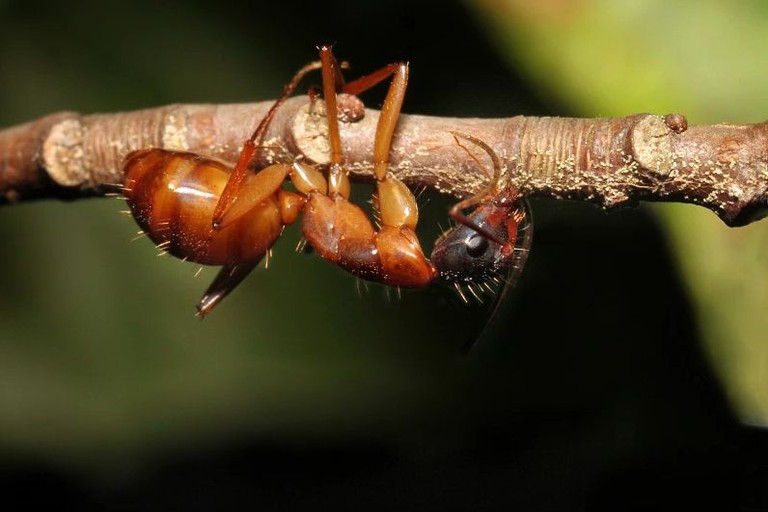
Yesterday (November 8, 2017), researchers at Penn State University released new information about one of Earth’s weirdest natural phenomena: zombie ants. These are carpenter ants in tropical locations, infiltrated and controlled by Ophiocordyceps unilateralis sensu lato, sometimes called zombie ant fungus. This fungal body-snatcher forces ants to a forest understory and compels them to climb vegetation and bite into the underside of leaves or twigs, where the ants die. The invasion culminates with the sprouting of a spore-laden fruiting body from a dead ant’s head. The fungus thereby benefits because infectious spores are released onto the ground below, where they can infect other foraging ants. The new research shows that the fungal parasite accomplishes all this without infecting the ants’ brains.
Instead, the new work shows, the zombie ant fungus surrounds and invades muscle fibers throughout the ant’s body. The study showed O. unilateralis s.l. cells present in a host ant’s head, thorax, abdomen and legs. What’s more, a large proportion of these fungal cells appeared to be connected to each other. They seemed to form a 3-D network, which, the researchers believe, might collectively control the ant’s behavior.
Maridel Fredericksen (@delfreddy on Twitter) was a master’s degree student in entomology at Penn State and is now a doctoral candidate at the University of Basel Zoological Institute, Switzerland. She’s lead author on the new research. Her team first infected ants with O. unilateralis s.l., then used serial block-face scanning-electron microscopy to create 3-D visualizations, with the goal of determining the distribution, abundance and interactions of the fungi inside the bodies of the ants. David Hughes, associate professor of entomology and biology at Penn State – known for his prior studies of zombie ants – said the use of this technology let the researchers make a breakthrough in understanding why zombie ants behave as they do. He said:
We found that a high percentage of the cells in a host were fungal cells. In essence, these manipulated animals were a fungus in ants’ clothing.
The research showed that, although fungal cells were concentrated directly outside the brain, no fungal cells were found inside the ants’ brains by these researchers. Hughes said:
Normally in animals, behavior is controlled by the brain sending signals to the muscles, but our results suggest that the parasite is controlling host behavior peripherally. Almost like a puppeteer pulls the strings to make a marionette move, the fungus controls the ant’s muscles to manipulate the host’s legs and mandibles.

The researchers said that, although the ant’s brain isn’t invaded by fungal cells, previous work has shown that the brain might be chemically altered by the parasite. Hughes said:
We hypothesize that the fungus may be preserving the brain so the host can survive until it performs its final biting behavior — that critical moment for fungal reproduction. But we need to conduct additional research to determine the brain’s role and how much control the fungus exercises over it.

Bottom line: Ophiocordyceps unilateralis sensu lato, sometimes called zombie ant fungus, doesn’t invade the brains of ants. Instead, it invades their whole bodies, forming an interconnected 3-D network that forces the ant to do its bidding.











